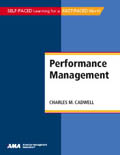Performance Management
Author: Charles M. Caldwell
Credit: 2.0 CEUs
Testing Format: multiple choice
Your Price: $159.00
ISBN: 9780761213925
Format: Book
Overview
Organizational success depends on the continuous improvement of staff performance at all levels.
People constitute the real competitive advantage in business and industries of all types. Enhancing the performance of your people and ultimately your organization depends on the continuous improvement of staff at all levels. An effective Performance Management system is essential to help employees perform at their best and align their contributions with the goals, values, and initiatives of the organization.
Performance Management presents managers and supervisors with a clear model they can follow to plan, monitor, analyze, and maintain a satisfying process of performance improvement for their staff. Designed for readers to apply what they are learning to their current job responsibilities, this course offers exercises and assessments to determine your readiness to implement performance management. It also illustrates strategies for developing the crucial communication skills of coaching, problem solving, and giving feedback while teaching methods for linking organization and personal goals.
By demystifying the role of performance management techniques, Performance Management provides the knowledge and tools to design and implement a workable system that benefits the organization and inspires employees to manage their own performance.
Course Objective: Gain the skills to plan, monitor, analyze, and maintain a performance management process.
Selected Learning Objectives
• Identify and remedy performance gaps
• Document performance with charts, graphs, reports
• Evaluate performance with BARS (Behaviorally Anchored Rating Scales
• Implement S.M.A.R.T. guidelines (specific, measurable, accountable, realistic, time frame)
• Establish non-monetary rewards through alignment, complement base pay, and other means
• Use training and development tools, such as self-study, seminars, in-house training, books, video, simulation, job rotation, and online training
Testing Format
This course contains one multiple choice test valued at two Continuing Education Units (CEUs).
Table of Contents
About This Course
How to Take This Course
Pre-Test
1. Getting Started with Performance Management 1
Performance Management Defined
Benefits
Are You Ready for Performance Management?
Making Performance Management Work
Communicate Expectations
Involve Employees in the Process
Use a Systematic Approach
Be Willing to Work Hard
Make a Commitment to Success
Performance Management Model
Step 1: Planning Performance
Step 2: Monitoring Performance
Step 3: Analyzing Performance
Step 4: Improving Performance
Step 5: Maintaining Performance
Recap
Review Questions
2. Planning Performance: What is Expected? 25
Providing Direction
Why Is Direction Important?
What Should Be Directed?
How Much Direction Is Required?
Using Job Descriptions
Defining Specific Responsibilities
Format and Content
Using Job Descriptions in a Changing Environment
Limits of Job Descriptions
Linking to Organization Goals
Involve Your Employees
Developing Performance Plans
Set Goals
Follow-Up
Maintain Accountability
Provide Support
Recap
Review Questions
3. Monitoring Performance: How Are We Doing? 45
Measuring Performance
Why Performance Measurement Is Important
Establishing Baseline Performance
Comparing Results to Established Goals
Reviewing Business Processes
Using Charts and Graphs
Gathering Performance Data
What Data Should Be Gathered?
How and When Will the Data Be Gathered?
How Will the Data Be Documented?
Observing Employee Performance
Prepare to Observe
Explain Why You Are Observing
Prepare an Observation Checklist
Observe More Than Once
Evaluate the End Result
Recognize the Effect of Your Observation
Remain Neutral During Your Observation
Recap
Review Questions
4. Analyzing Performance: What Performance Gaps Exist? 69
Performance Gaps
Is the Employee Doing Anything About the Performance Gap?
Is the Performance Gap Important Enough to Fix?
The Causes of Performance Gaps
Does the Performer Know What Is Expected?
Is the Performer Receiving Feedback About Performance?
Does the Performer Have the Necessary Knowledge and Skill to Perform the Job?
Is the Performer Willing to Do the Required Job?
Is There a Task Interference That Prevents Doing the Job?
Do Consequences Match the Performance?
Does the Performer Have the Capacity to Do the Job?
Potential for Improved Performance
What’s the Cost of Eliminating the Performance Gap?
Benefits of Eliminating Performance Gaps
Recap
Review Questions
5. Improving Performance: How Can We Make It Better? 87
System Strategies to Improve Performance
Organization Strategies
Environment Strategies
Using Training and Development to Improve Performance
What Is Training?
Why Do We Train?
Matching Training and Development with Performance Needs
Sources for Training and Development
Using Coaching and Mentoring to Improve Performance
Coaching
Mentoring
Coaching and Mentoring Goals
Performance Improvement Coaching
Using Performance Action Plans to Improve Performance
Developing a Performance Action Plan
Some Practical Considerations
Recap
Review Questions
6. Maintaining Performance: How Do We Keep Performance On Track? 113
Using Feedback to Maintain Performance
Feedback Systems
Positive Feedback
Corrective Feedback
Using Performance Appraisal to Maintain Performance
What Makes the Process Work?
What Should the Appraisal Cover?
What Rating System Should Be Used?
What Performance Categories Should Be Used?
How Should the Appraisal Meeting Be Conducted?
Pay for Performance System
Pay and Organization Strategy
Pay as a Reward for Performance
Planning for Pay
Nonmonetary Rewards for Performance
Alignment
Complement Base Pay
Low Cost Nonmonetary Rewards
Unique Approaches to Nonmonetary Rewards
Recap
Review Questions
7. Implementing Performance Management 141
Organization Culture and Performance Management
Strategies in a Nonsupportive Organization Culture
Implement a “Local” Performance Management System
Implement Parts of the System
Build Support from Within
Keys to a Successful Performance Management System
Communicate Expectations
Involve Employees in the Process
Use a Systematic Approach
Be Willing to Work Hard
Make a Commitment to Success
Reevaluate Your Readiness for Performance Management
Develop an Implementation Action Plan
Recap
Review Questions
Post-Test
Bibliography
Index

